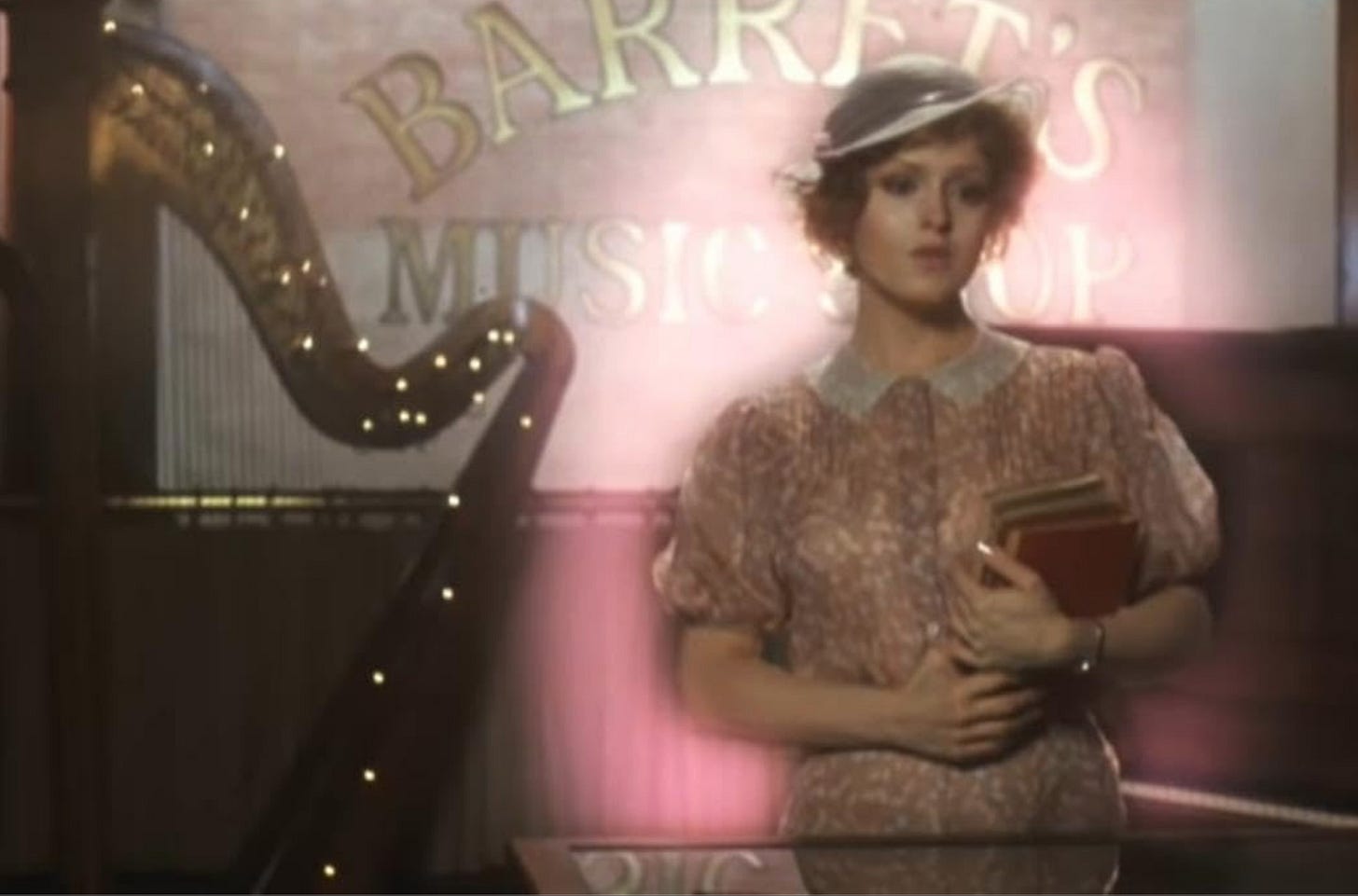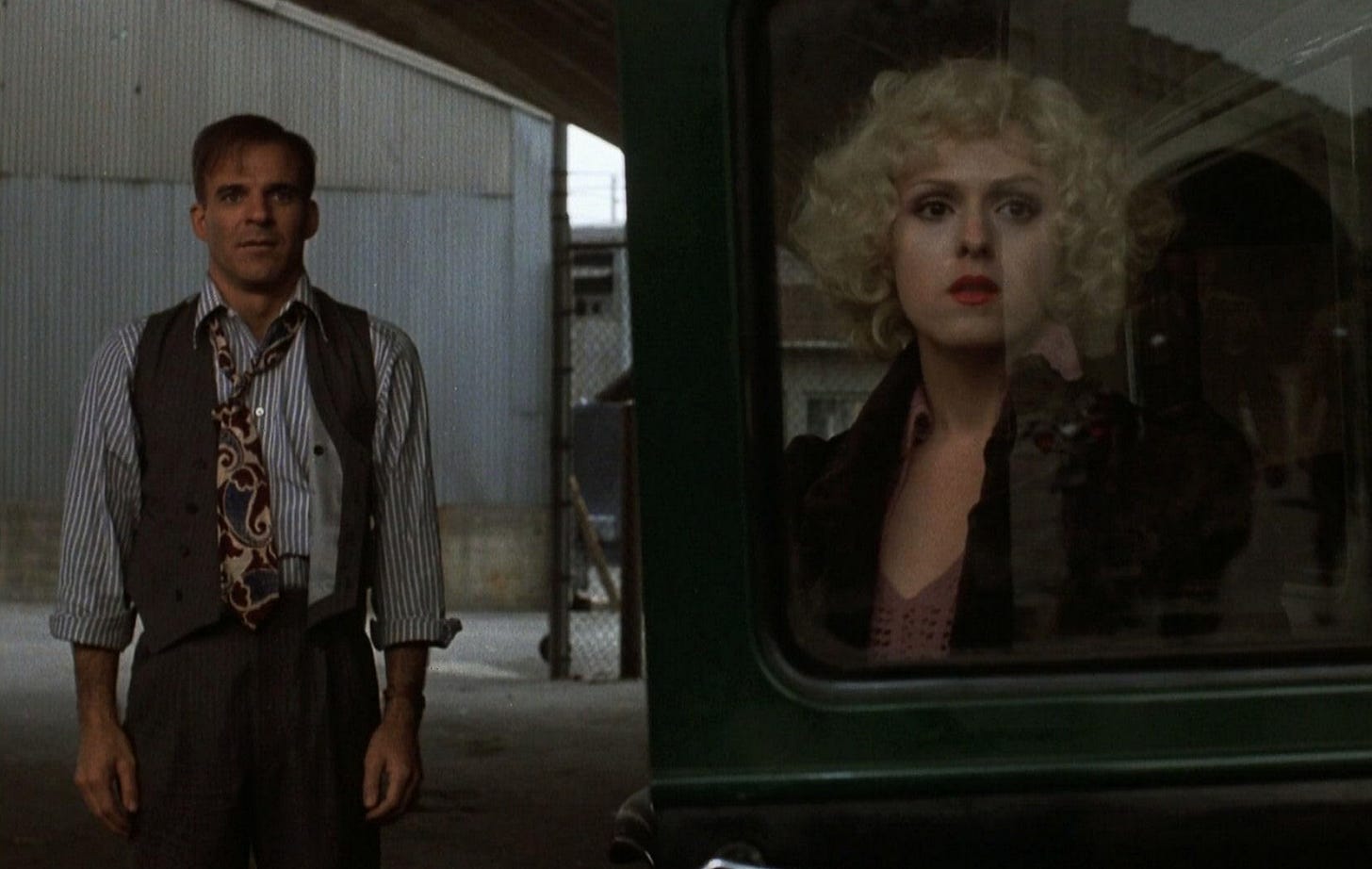Heavy Wool, Light Silk: The Costume Language of Escape in “Pennies from Heaven”
How Bob Mackie’s 1981 costume design predicted our age of digital self-performance
Editor’s Note: Yelena Fradlis is a board member of Cognitive Frames and the driving creative force behind our events, our collateral, and our design. More importantly, she’s spent over 15 years building fashion brands that understand how clothing shapes identity, working at the intersection where fashion meets cultural narrative—exactly the territory Bob Mackie was exploring in 1981.
As someone who has spent decades crafting brand identities that help people perform their aspirational selves, she recognized in Mackie’s work a prescient understanding of how we use appearance to bridge the gap between who we are and who we dream of being.
Her insight that contemporary fashion marketing essentially follows Mackie’s playbook—heavy wool reality, light silk fantasy—reframes his 1981 achievement as cultural prophecy rather than period piece. — D.H.
When Pennies from Heaven was released in 1981, it divided critics. Was it a surrealist failure, or a misunderstood masterpiece? A Depression-era musical starring Steve Martin, it told a grim story—poverty, longing, moral collapse—then undercut it with glitzy musical numbers lip-synced to old 1930s songs. But more than the musical conceit, what really drives the film’s internal split is the costuming—meticulously orchestrated by Bob Mackie and Ray Aghayan.
Mackie, the maestro behind Cher’s most iconic looks and a godfather of TV glamour, brought a distinctly theatrical and psychological edge to the film’s wardrobe. Here, clothing doesn’t just decorate the scene—it narrates the unspoken story. The costumes aren’t just period-accurate; they are characters in themselves, surfacing emotion, delusion, and desire.
Pauline Kael called it "the most emotional movie musical I've ever seen," praising Bob Mackie specifically for work at his "highest capacity." Meanwhile, Roger Ebert found it "dazzling and disappointing in equal measure," and Vincent Canby called it "chilly." This critical schism wasn't about the film's quality—it was about whether audiences were ready for musicals that refused to comfort. Mackie's costumes were central to this discomfort: they made visible the gap between who we are and who we pretend to be.
Mackie1, the maestro behind Cher's most iconic looks and a godfather of TV glamour, brought a distinctly theatrical and psychological edge to the film's wardrobe. Here, clothing doesn't just decorate the scene—it narrates the unspoken story. The costumes aren't just period-accurate; they are characters in themselves, surfacing emotion, delusion, and desire.
THEN VS. NOW: WE STILL DRESS OUR ESCAPES
In today’s age of digital duality—where Instagram personas, filters, and AI avatars often feel more “real” than our everyday lives—Mackie’s work feels eerily relevant. Pennies from Heaven asks: who are we when the world is hard and we have no control? And more importantly, how do we use appearance—clothing, style, aesthetic—to rewrite our narrative?
The characters in Pennies do what we do now on screens every day: they costume their fantasy selves. The only difference is that in 1981, that transformation played out in grand musical numbers. Today, it happens in our social feeds, dating profiles, and algorithm-fed dreams.
ARTHUR: A MAN IN A SUIT THAT DOESN’T FIT
Steve Martin’s Arthur is a sheet music salesman who wants life to be as beautiful as the songs he sells. In the real world, his suits are boxy, tired—fabric that sags with financial strain. But when he dreams, he steps into shiny tuxedos, white ties, soft lighting. Mackie’s costumes illuminate a deep tension: Arthur is collapsing into fantasy because reality offers no script he wants to read from.
Mackie differentiates Arthur's real and fantasy wardrobes through fabric weight alone. The real-world suits are heavy wool gabardine that literally weighs him down. The fantasy tuxedos are featherweight silk that allows Martin to float through his tap routines. This isn't just costuming—it's physics as psychology.
Martin trained for eight months learning to tap dance for what he considered "the greatest thing [he'd] ever seen"—the original BBC version. This was a comedian literally learning new movements to escape his own typecasting—a meta-layer that enriches every costume change.
The modern parallel is unmistakable. We curate our lives to appear more successful, more romantic, more cinematic than they are more cinematic than they are—but unlike Arthur's fantasies, our performed selves leave digital fossils. Every filtered selfie is a tiny musical number, complete with costume (what we wear), set design (where we shoot), and soundtrack (what song we add). Mackie's work predicts not just Instagram but the entire apparatus of digital self-performance.
EILEEN: THE TRANSFORMATION OF A WOMAN’S BODY AND VOICE
Bernadette Peters’ character, Eileen, starts off in strict, unflattering silhouettes: wool skirts, muted cardigans, thick-soled shoes. But as she enters Arthur’s fantasies—and her own—she becomes transformed. Mackie puts her in clingy satin, sheer robes, feathers, and flawless 1930s waves. She becomes the dream girl, a tragic starlet conjured from celluloid memory.
Mackie achieved this transformation through specific material choices: the shift from boiled wool to bias-cut satin literally changes how Peters moves. Watch her walk—the fabric forces a different gait, a different relationship to her own body. This is costume as choreography.
Today, this storyline plays out differently but similarly: a woman stepping into her power through performance and style—but always under the gaze of a culture that commodifies transformation. Mackie understood this decades ago. His costumes don’t just beautify Eileen—they expose the emotional price of being looked at.
COSTUMES AS COMMENTARY
What makes Mackie’s contribution unforgettable is that he never designs just “clothes.” He designs psychological states. In Pennies, the glamour is never just pretty—it’s dangerous. The more dazzling the fantasy, the further the fall. The costumes are costumes within costumes: what characters imagine they deserve, stitched over what they fear they truly are.
That resonates today more than ever. We live in an era of hyper-performance, where style is identity, and aesthetics double as coping mechanisms. Mackie’s work reminds us that appearances—no matter how perfect—always carry narrative weight. What we wear says what we can’t admit.
THE LEGACY
Pennies from Heaven may not be for everyone. It’s dark, strange, and unapologetically theatrical. But in Mackie’s costuming lies a truth we’re still reckoning with: we all costume our way through life, toggling between truth and illusion, depression and dazzle, honesty and curation.
In 2025, as we navigate AI faces, stylized TikToks, and designer dupe culture, Mackie’s vision feels prophetic.
He saw long ago that fashion isn't frivolous—it's survival. Every time we curate our lives for public consumption, every time we dress for the job we want rather than have, we're proving his point: the costume is never just fabric. It's the story we're desperate to believe.
WHERE TO WATCH
Pennies from Heaven is available to stream for rent or purchase on Apple TV and Amazon Prime
No Blu-ray edition has been released, but the original DVD can be found on Amazon.com
Bob Mackie and Ray Aghayan were nominated for a BAFTA for Best Costume Design in Pennies from Heaven, though the film was largely overlooked at the Oscars. Time has proven their contribution to be not just aesthetic but radical—paving the way for costume design as narrative language.







This is an interesting and astute approach to the film. I've never given much thought to the weight of clothing, and how it affects an actor's gait or stance. Pennies From Heaven is a movie I've meant to rewatch for a long, long time. I only saw it once, when my parents rented the video. We'd loved The Jerk, Dead Men Don't Wear Plaid, and The Man With Two Brains, which I think at the time was the entirety of Martin's body of work, at least as a star. I recall my parents loving the dancing in the movie, but being put off by how vulgar the film was outside of that. I don't remember very much, other than how pretty I thought Bernadette Peters was. Now, if when I watch, I'll pay attention to how the clothing plays a role!